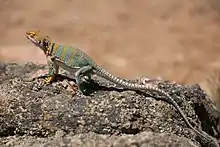Crotaphytidae
The Crotaphytidae, or collared lizards, are a family[1][2][3] of desert-dwelling reptiles native to the Southwestern United States and northern Mexico. Alternatively they are recognized as a subfamily, Crotaphytinae, within the clade Pleurodonta. They are very fast-moving animals, with long limbs and tails; some species are capable of achieving bipedal running at top speed. This species is carnivorous, feeding mainly on insects and smaller lizards.
| Crotaphytidae | |
|---|---|
 | |
| Crotaphytus collaris | |
| Scientific classification | |
| Kingdom: | Animalia |
| Phylum: | Chordata |
| Class: | Reptilia |
| Order: | Squamata |
| Suborder: | Iguania |
| Clade: | Pleurodonta |
| Family: | Crotaphytidae H.M. Smith & Brodie, 1982 |
| Genera | |
The male lizards can be highly territorial and will defend their home range area. Defending their territory can help promote a higher chance of survival and reproduction by excluding potential competitors from their territory. Certain morphological traits of the male lizards may play a role in them obtain a well quality area. The characteristics traits of Crotaphytus dickersonae are sexually dimorphic. Males with longer tails had better quality territory with higher female presence in their territory and less overlap with other male territories.[4]
Along with the male lizards defending their territory to increase their change to mate, the Crotaphytidae also broadcast visual displays. frequency of the broadcast displaces decrease as the ratio of same-sex competitors to females increases. The frequency of displaces has a positive increase with courtship frequency. The average frequency when the males courted females (x ± 1.0SE = 1.43 ± 0.10) was 6.8 times higher (t1,96 = 11.7, P < 0.0001) than the frequency with which they initiated contests with same sex rivals (0.21 ± 0.03).The display can be describe as pushups formate as the most common broadcast displays for males in the Arcadia Lake population.[5]
Within the female lizard population, there has been some debate of them being territorial. In a study observing the levels of intrasexual aggression and the social among neighboring females population of C. collaris in Oklahoma, the female population showed increase levels of intrasexual aggression when ecological conditions are scarce. There was an increase frequency of aggression when female densities were high. The availability of perches and refugia affects competition due to their strategy of sit-and-wait foraging behavior of anthropods. The evaluated rock perches allow more effective scanning of prey is a critical resource for lizards. Within their territories, there was 2+ females dominant over yearlings, with an average dominance index that was 2.2 times higher (t17¼3.57, p¼0.002) than that of yearlings (33.3).[6]
Technical characters
- Femoral pores present
- Interparietal scale small (distinctly smaller than ear opening)
- Never have an enlarged middorsal scale row or fringe
- Never have a divided rostral scale
- No bony spines or projecting ridges on their heads
- No scales projecting over their ears, and no scales forming a prominent fringe on sides of toes as in Phrynosomatidae
Species
Genus Gambelia Baird, 1859[7][8] (leopard lizards)
- Cope's leopard lizard – Gambelia copeii (Yarrow, 1882)
- blunt-nosed leopard lizard – Gambelia sila (Stejneger, 1890)
- long-nosed leopard lizard – Gambelia wislizenii (Baird & Girard, 1852)
Genus Crotaphytus Holbrook, 1842[7][9] (collared lizards)
- venerable collared lizard – Crotaphytus antiquus Axtell & Webb, 1995
- desert collared lizard – Crotaphytus bicinctores N.M. Smith & W.W. Tanner, 1972
- common collared lizard – Crotaphytus collaris (Say, 1823)
- Dickerson's collared lizard – Crotaphytus dickersonae K.P. Schmidt, 1922
- Grismer's collared lizard – Crotaphytus grismeri McGuire, 1994
- Eastern collared lizard – Crotaphytus insularis Van Denburgh & Slevin, 1921
- Sonoran collared lizard – Crotaphytus nebrius Axtell & Montanucci, 1977
- reticulated collared lizard – Crotaphytus reticulatus Baird, 1858
- Baja collared lizard – Crotaphytus vestigium N.M. Smith & W.W. Tanner, 1972
Nota bene: A binomial authority in parentheses indicates that the species was originally described in different genus.
References
- Townsend, Ted M.; Mulcahy, Daniel G.; Noonan, Brice P.; Sites, Jack W. Jr; Kuczynski, Caitlin A.; Wiens, John J.; Reeder, Tod W. (2011). "Phylogeny of iguanian lizards inferred from 29 nuclear loci, and a comparison of concatenated and species-tree approaches for an ancient, rapid radiation". Molecular Phylogenetics and Evolution. 61 (2): 363–380. doi:10.1016/j.ympev.2011.07.008. PMID 21787873.
- Wiens, John T.; Hutter, Carl R.; Mulcahy, Daniel G.; Noonan, Brice P.; Townsend, Ted M.; Sites, Jack W. Jr.; Reeder, Tod W. (2012). "Resolving the phylogeny of lizards and snakes (Squamata) with extensive sampling of genes and species". Biology Letters. 8 (6): 1043–1046. doi:10.1098/rsbl.2012.0703. PMC 3497141. PMID 22993238.
- Pyron, R. Alexander; Burbrink, Frank T.; Wiens, John J. (2013). "A phylogeny and revised classification of Squamata, including 4161 species of lizards and snakes". BMC Evolutionary Biology. 13: 93. doi:10.1186/1471-2148-13-93. PMC 3682911. PMID 23627680.
- Faber, Lieke; Plasman, Melissa; Duchateau, Marie José (June 2018). "Territorial patterns of Dickerson's collared lizard, Crotaphytus dickersonae". Revista Mexicana de Biodiversidad. 89: 1127–1137 – via Scielo.
- Baird, Troy (2012). "Male collared lizards, Crotaphytus collaris (Sauria: Crotaphytidae), signal females by broadcasting visual displays". Biological Journal of the Linnean Society. 108(3): 636–646 – via Oxford Academic.
- Baird, Troy; Sloan, Chris (2003). "Interpopulation Variation in the Social Organization of FemaleCollared Lizards,Crotaphytuscollaris". Ethology. 109(11): 879–894 – via Wiley Online Library.
- Dahms Tierleben. www.dahmstierleben.de/systematik/Reptilien/Squamata/Iguania/crotaphytidae.
- Genus Gambelia at The Reptile Database www.reptile-database.org.
- Genus Crotaphytus at The Reptile Database www.reptile-database.org.
Further reading
- Frost DR, Etheridge RE (1989). A Phylogenetic Analysis and Taxonomy of Iguanian Lizards (Reptilia: Squamata) Univ. Kansas Mus. Nat. Hist. Misc. Publ. 81: 1-62. (Family Crotaphytidae, p. 36).
- Smith HM, Brodie ED Jr (1982). Reptiles of North America: A Guide to Field Identification. New York: Golden Press. 240 pp. ISBN 0-307-13666-3. (Subfamily Crotaphytinae, p. 106).